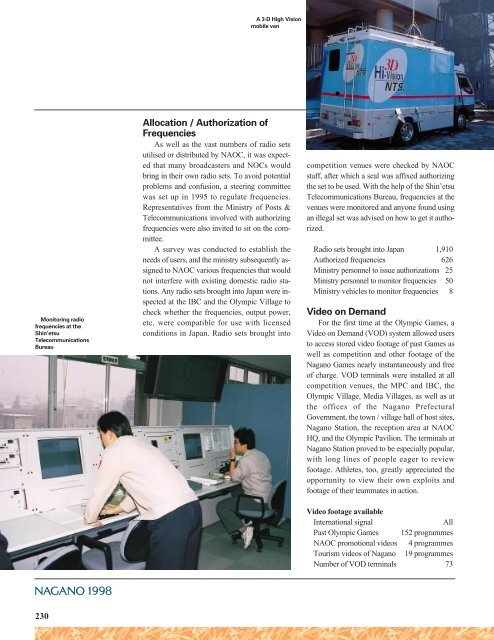107th IOC Session - LA84 Foundation
107th IOC Session - LA84 Foundation
107th IOC Session - LA84 Foundation
You also want an ePaper? Increase the reach of your titles
YUMPU automatically turns print PDFs into web optimized ePapers that Google loves.
Monitoring radio<br />
frequencies at the<br />
Shin’etsu<br />
Telecommunications<br />
Bureau<br />
230<br />
A 3-D High Vision<br />
mobile van<br />
Allocation / Authorization of<br />
Frequencies<br />
As well as the vast numbers of radio sets<br />
utilised or distributed by NAOC, it was expected<br />
that many broadcasters and NOCs would<br />
bring in their own radio sets. To avoid potential<br />
problems and confusion, a steering committee<br />
was set up in 1995 to regulate frequencies.<br />
Representatives from the Ministry of Posts &<br />
Telecommunications involved with authorizing<br />
frequencies were also invited to sit on the committee.<br />
A survey was conducted to establish the<br />
needs of users, and the ministry subsequently assigned<br />
to NAOC various frequencies that would<br />
not interfere with existing domestic radio stations.<br />
Any radio sets brought into Japan were inspected<br />
at the IBC and the Olympic Village to<br />
check whether the frequencies, output power,<br />
etc. were compatible for use with licensed<br />
conditions in Japan. Radio sets brought into<br />
competition venues were checked by NAOC<br />
staff, after which a seal was affixed authorizing<br />
the set to be used. With the help of the Shin’etsu<br />
Telecommunications Bureau, frequencies at the<br />
venues were monitored and anyone found using<br />
an illegal set was advised on how to get it authorized.<br />
Radio sets brought into Japan 1,910<br />
Authorized frequencies 626<br />
Ministry personnel to issue authorizations 25<br />
Ministry personnel to monitor frequencies 50<br />
Ministry vehicles to monitor frequencies 8<br />
Video on Demand<br />
For the first time at the Olympic Games, a<br />
Video on Demand (VOD) system allowed users<br />
to access stored video footage of past Games as<br />
well as competition and other footage of the<br />
Nagano Games nearly instantaneously and free<br />
of charge. VOD terminals were installed at all<br />
competition venues, the MPC and IBC, the<br />
Olympic Village, Media Villages, as well as at<br />
the offices of the Nagano Prefectural<br />
Government, the town / village hall of host sites,<br />
Nagano Station, the reception area at NAOC<br />
HQ, and the Olympic Pavilion. The terminals at<br />
Nagano Station proved to be especially popular,<br />
with long lines of people eager to review<br />
footage. Athletes, too, greatly appreciated the<br />
opportunity to view their own exploits and<br />
footage of their teammates in action.<br />
Video footage available<br />
International signal All<br />
Past Olympic Games 152 programmes<br />
NAOC promotional videos 4 programmes<br />
Tourism videos of Nagano 19 programmes<br />
Number of VOD terminals 73
















